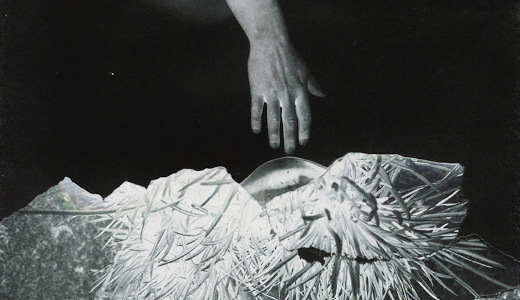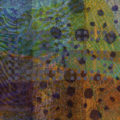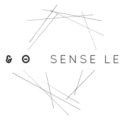What I like are the mixing of layers with distinctly foreshadowed build-up and release, I feel a state of hypnotism and heightened consciousness. The tracks are quite lengthy to allow for a mid-song climax followed by a soft breakdown disposing of beats and percussion entirely, leaving the atmospherics to stand alone for an extended period.

The kind of music that hypnotizes
The usage of repetitive rhythms to induce trance states is an ancient phenomenon. In music, a drone is a long and sustained sound, usually a harmonic or monophonic effect or accompaniment where a note or chord is continuously sounded throughout most or all of a piece, achieved through a sustained sound or through repetition of a note. Ivan Muela wanted to take a single held tone or chord and spread it over time like paint on a canvas, observing the subtle harmonic shifts and drifts take place as the tracks slowly morph from faint distant tones to solid distorted soundscapes. The process was meditative, cathartic and at times violent—but ultimately human and fragile.
I hear classical-drone loops that soothe and mesmerize, polyharmonics, multiphonics, and percussive polyrhythms attempting to achieve a half-conscious state characterized by an absence of response to external stimuli. Ibidem is a collaborative project between experimental composer Iván Muela and visual artist Meneh Peh. Soul flight comes to my mind, also known as shamanic journeying or magical flight, presented as a 3-hour drone ambient album accompanied by a book of analog photo collages inspired by the music and the creative process behind it. This is the kind of music that hypnotizes you. Drones have often been used to spotlight dissonance purposefully. Many people now also associate the word “drone” with flying remote-control aircraft. The sound is distinct. Not everyone experiences the same thing. Among the many tasks that practitioners believe could be accomplished through soul flight are healing, divination, protection, clairvoyance, dream interpretation, mediation between the divine and the humane, communicating with spirits of the dead (séance), and escorting deceased souls to the afterlife. The intention of the oldest practitioners is to create a sonic space that would enable people to interact with the spiritual world on behalf of the community. This can be difficult listening, unless you are able to find that place inside, which might range from achieving a deep dreamless sleep to something like a state of high psychic arousal.
“I’ve always been fascinated by the movement embedded in apparent stillness, like when you focus your attention on the surface of a lake and start noticing the ever-evolving patterns and the chaos happening in the water.”
To drone is to make a low, continuous noise that sounds like humming or buzzing, sometimes with a rich, vibrant and animated resonance, a single, unified vibratory system, and sometimes with dissonant harmonics. A drone on the same pitch as a melodic note tends to both hide that note and to bring attention to it by increasing its importance. Sometimes an ecstatic experience takes place on occasion of contact with something or somebody perceived as extremely beautiful or holy. It may also happen without any known reason. You might want to remain seated. Check your straps.
Each track is made using one single signal chain ::
What I like are the mixing of layers with distinctly foreshadowed build-up and release, I feel a state of hypnotism and heightened consciousness. The tracks are quite lengthy to allow for a mid-song climax followed by a soft breakdown disposing of beats and percussion entirely, leaving the atmospherics to stand alone for an extended period. This can bring an induced emotional feeling, high, euphoria, chills, or uplifting rush that listeners claim to experience, or it may indicate an actual trance-like state. Other listeners might sometimes get headaches.
The drone has historically been a technique associated with hypnosis, meditation, magic, flow, prayer, and altered states of consciousness, cognitive loops where a cognitive object (a thought, an image, a sound, an intentional action) repeats long enough to result in various sets of disabled cognitive functions, and sometimes ecstasy is an additional form. Sound can influence all the different states of mind, emotions, moods and daydreams that human beings experience. This can provide a way for the mind to change the way it filters information in order to provide more efficient use of the mind’s resources. This can bring to the surface a way of accessing the unconscious mind for the purposes of relaxation, healing, intuition and inspiration, something endemic to the human condition and a Human Universal.
Is a purpose of art something that can be a function in religious and mystical experience? All this intense focusing of attention, which is the key psychological mechanism of trance induction, and for healing sleep, communing with spirits, promoting dreams in the seeker. This too is music. As the experience of mystics generally entails direct connection, communication and communion with the divine; trance and cognate experience are endemic. Some might experience visions, voices, clairvoyance, out-of-body experiences, and make contact with supernatural or spiritual beings, talking about receiving new information as a revelation, also religion-related explanations of subsequent change of values, attitudes and behavior. For some others, not so much. It does not always connect to everyone. Breathing and heart rate have been shown to be affected by auditory stimulus, along with brainwave activity. The ability of rhythmic sound to affect human brainwave activity, especially theta brainwaves, is the essence of auditory driving, and is the cause of the altered states of consciousness that it can induce.
“I do not think the hypothesis of coincidence can cover the facts. It is one of several incidents in my life which have convinced me of spiritual interposition—of the promptings of some beneficent force outside ourselves which tries to help us where it can.” said Arthur Conan Doyle. I should like to see a census of all the minds which embrace a belief in the truth of supernormal phenomena. We should see something quite different; something even distinct and apart from religion. The titles are provocatively simple, “Drone Study I” (15:51), “Drone Study II” (16:10), “Drone Study III” (19:09), “Drone Study IV” (36:22), “Drone Study V” (48:28), and finally, “Drone Study VI” (35:57). “Each track is made using one single signal chain, often consisting of my own handmade synthesizers, housed in coffee tins and glass jars, and a series of guitar pedals.”
Iván Muela is a multi-instrumentalist, composer and sound artist based in London, blending an aggressive approach to playing with a distinctive sense of intimacy and an insatiable search for unconventional sonic textures. His music relies heavily on warm-sounding pianos, strings and electroacoustic experiments, ultimately resulting in a sway of beautiful melodies and fascinating textures. Iván has performed his music in a number of spaces across Europe, from intimate piano concerts to experimental noise events. His semi-improvised live sets combine piano, tape loops, guitar pedals and contact mics, generating a constantly-evolving soundscape that revolves around the classical, ambient and avant-garde.
Iván was born in the cold and quiet Pamplona in North Spain, he remembers waking up every morning with the sounds of The Beatles or Neil Young blasting from his living room. Placing special emphasis on capturing the moment, his compositions are splattered with improvisation and chance. Iván is fascinated by the way technology can become an essential part of the compositional process.
Adventurous Music is a non-profit micro-label releasing experimental electronic music in small editions. As a format, we have chosen limited printed goods (like cards and books) that include visual art and a download code for the music
Ibidem is available on Adventurous Music. [Bandcamp]




















![Luke’s Anger :: Ceiling Walker EP (Love Love) — [concise]](https://igloomag.com/wp/wp-content/uploads/2025/04/lukes-anger-ceiling-walker-vinyl_feat-75x75.jpg)

![Ndorfik & madebyitself :: Solos EP (People Can Listen) — [concise]](https://igloomag.com/wp/wp-content/uploads/2025/04/ndorfik-madebyitself-solos_feat-75x75.jpg)




